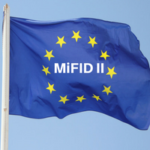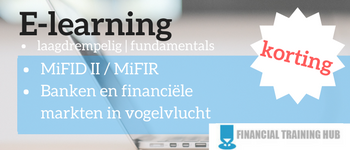MiFID II regulering van de georganiseerde handel
| 12-03-2018 | Michiel van den Broek |

De Europese MiFID regels hebben als hoofddoelstellingen om de Europese financiële markten efficiënter en transparanter te maken en om de bescherming van beleggers te vergroten. De MiFID II regels trachten zoveel mogelijk handelsvormen te reguleren. Deze regulering heeft betrekking op de dienstverlening en beleggingsactiviteiten van beleggingsondernemingen en exploitanten van gereglementeerde markten. Bij het verlenen van beleggingsdiensten kan een beleggingsonderneming op verschillende manieren transacties in financiële instrumenten uitvoeren: (1) als tussenpersoon en (2) voor eigen rekening.
Transacties uitvoeren via een tussenpersoon
Hierbij voert de beleggingsonderneming als tussenpersoon een klantorder uit voor rekening van de klant op basis van execution only, dan wel in het kader van beleggingsadvies of vermogensbeheer.
Transacties voor eigen rekening
Bij handel voor eigen rekening sluit de beleggingsonderneming een transactie af met eigen rekening en voor eigen risico.
Klantorders afhandelen als tussenpersoon op de georganiseerde markt
De beleggingsonderneming kan een klantorder:
Doorgeven aan een externe handelsplatform.
- Een gereglementeerde markt (beurs)
- Een alternatief handelsplatform, oftewel een Multilateral Trading Facility (MTF)
- Een georganiseerde handelsfaciliteit, een Organised Trading Facility (OTF)
Uitvoeren zonder inschakeling van een externe partij.
- Via interne afhandeling, oftewel Systematische Internalisatie (SI)
Ad a en b Gereglementeerde markt en MTF
Voor de gereglementeerde markt gelden de MiFID II regels voor gereglementeerde markten. Voor overige exploitanten van een MTF zijn de MiFID II regels voor beleggingsondernemingen van toepassing. De MiFID II regels voor gereglementeerde markten en MTF zijn vergelijkbaar maar niet helemaal identiek. Belangrijke verschillen zijn de vergunningsvereisten, de prospectusverplichting voor toelating tot de handel en de afwikkeling van transacties.
Samenvattend is een gereglementeerde markt aan meer regels gebonden, biedt meer beleggersbescherming en is duurder dan een MTF. In de praktijk zijn MTF’s geduchte concurrenten van beurzen. Deze concurrentie sluit aan bij een hoofddoelstelling van de MiFID regels, het efficiënter maken van handel op Europese financiële markten.
De handel op gereglementeerde markten en MTF’s verloopt via niet-discretionaire regels. Niet-discretionair betekent dat er geen enkele mogelijkheid mag zijn de aan- en verkoopbeslissingen te beïnvloeden.
Een beleggingsonderneming moet de nadrukkelijke toestemming van de klant hebben om klantorders buiten een gereglementeerde markt of MTF uit te voeren.
Ad c: Handel via een Organised Trading Facility (OTF)
Om binnen de Europese Unie de financiële markten transparanter en efficiënter te maken en concurrentieverhoudingen tussen handelsplatformen meer gelijk te maken, introduceert MiFID II de georganiseerde handelsfaciliteit (Organised Trading Facility, OTF). MiFID II definieert de OTF ruim om te bereiken dat elk handelssysteem onder toezicht komt naast de gereglementeerde en de MTF handel. Aangezien de G-20 de handel in bepaalde OTC-derivaten in de toekomst verplicht via een elektronisch handelsplatform wil laten verlopen, is het te verwachten dat deze ook onder de MiFID II regels voor OTF gaan vallen.
De OTF handel verschilt in twee belangrijk aspecten van de gereglementeerde en MTF handel: verhandelde producten en regels van handel.
OTF verhandelbare producten
Op een OTF mag geen handel plaatsvinden in aandelen (equity) of daaraan verbonden instrumenten. Er mag alleen worden gehandeld in non-equity instrumenten, zoals obligaties, gestructureerde financiële producten, emissierechten en derivaten.
OTF regels van handel
Op een OTF handelsplatform is er sprake van het afsluiten van orders via matching op basis van discretionaire regels. Matching bestaat uit het bijeenbrengen van tegengestelde klantorders. Discretionair betekent dat de beleggingsonderneming die de OTF exploiteert invloed heeft op welke orders met elkaar worden gematcht.
Deze invloed om een order te plaatsen, in te trekken of te matchen is mogelijk omdat de OTF exploitant bij de transactie handelt voor rekening van zowel koper als verkoper. De OTF exploitant kan ook de totstandkoming van een potentiële transactie faciliteren door partijen bij elkaar te brengen. Omdat beïnvloeding mogelijk kunnen kan er voor de exploitant een belangenconflict optreden waardoor de exploitant niet in het belang van de klant handelt. Om de belegger hiertegen te beschermen gelden er strenge zorgplichtregels.
OTF voorbeelden: agency crossing en matched principal trading
Een agency crossing system is een voorbeeld van een OTF waarbij matching van orders tot stand komt doordat de exploitant voor rekening handelt voor beide klanten. Een variant op de OTF is matched principal trading (back-to-back handel), waarbij de exploitant twee tegengestelde posities van klanten bijeenbrengt door transacties voor eigen rekening af te sluiten met dezelfde looptijd. Hierdoor wordt hetzelfde bereikt als bij matching via een agency crossing. Echter, bij matched principal trading moet de opdrachtgevers toestemming geven om de transactie af te sluiten, hetgeen bij agency crossing niet nodig is. Om de opdrachtgevers te beschermen, mag de exploitant bovendien geen marktrisico lopen. Dit betekent dat de bemiddelaar geen winst of verlies maakt, afgezien van de vooraf bekendgemaakte provisies, vergoedingen of kosten van de transactie
Ad d: Systematische internalisatie (SI)
In plaats van inschakeling van een externe partij kan een beleggingsonderneming een klantorder ook intern (in-house) uitvoeren zonder gebruik van een multilateraal handelssysteem systeem. Er is dus sprake van een bilaterale handel om klantorders af te sluiten. In plaats een klant als tegenpartij te zoeken om een tegenovergestelde klantorder uit te voeren, treedt de beleggingsonderneming zelf op als tegenpartij. Deze handelsvorm is een combinatie van de beleggingsdienst handel voor rekening van de klant met de beleggingsactiviteit handel voor eigen rekening van de beleggingsonderneming volgens niet-discretionaire regels. Een verschil met een OTF is dat ook aandelen (equity) of daaraan verbonden instrumenten mogen worden verhandeld.
Bij multi dealer platform treden meerder beleggingsondernemingen op als handelaar voor eigen rekening. Een single dealer platform is een handelsplatform waarbij één beleggingsonderneming steeds optreedt voor klanten door voor eigen rekening posities in te nemen.
In vergelijking tot beurs, MTF en OTF gelden er voor interne afhandeling minder regels voor transparantieplicht voorafgaande aan de handel.

Owner of Hecht Consult



 Ontvang via treasuryXL korting op deze e-learning en/of de
Ontvang via treasuryXL korting op deze e-learning en/of de  MIFID II – you read about it frequently. And there are more abbreviations: you will also find MIFIR and MIFID I. As a banker you will know what we are talking about. As a treasurer or financial professional you are supposed to understand what MIFID II will bring you. We think it is time to zoom in on this subject and present a short summary.
MIFID II – you read about it frequently. And there are more abbreviations: you will also find MIFIR and MIFID I. As a banker you will know what we are talking about. As a treasurer or financial professional you are supposed to understand what MIFID II will bring you. We think it is time to zoom in on this subject and present a short summary. Annette Gillhart – Community Manager treasuryXL
Annette Gillhart – Community Manager treasuryXL
